Gauges & Computers
2016 Update
Computers and electronics change so fast it is hard to keep up with it. The general recommendations below should hold up pretty well even as the technology races forward.
The dive computer should be considered standard equipment. Diving with a computer will give you more bottom time and more safety margin than crude estimating with dive tables. If you are buying your first set of gear, get a computer rather than analog gauges, and you will not regret it. There is a great deal of variation in the design and operation of dive computers. Among the choices you can make are:
- air-integrated or not
- conservative vs. liberal algorithms
- violation lock-out mode
- Nitrox-ready or not
- wrist, console or hose mounted
- dive logging & PC interface
- backlighting for night diving
- auto-on vs. manual-on
When you are buying a computer, it is important to evaluate how easy the computer is to use and how clear its displays are. Some computers have a profusion of dots, symbols, and little numbers in the display. This is not necessarily a good thing. Remember, you may want to show the readout to someone else underwater, and he or she should not have a major problem deciphering it. Neither should you, for that matter! Easy-to-read tissue-loading bar graphs are standard on all modern computers - the lack of this feature is a sure sign of an older and probably obsolete model that you should avoid. Likewise, alternating A/B displays should be avoided - all important information should be displayed all the time. Finally, if you plan to get into any sort of decompression diving, it is nice to have a computer that tells you how long a deco stop will be, rather than just telling you need to do one.
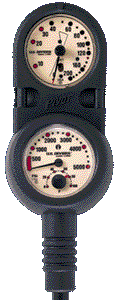
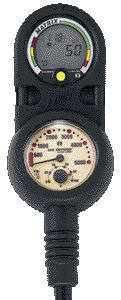
Air-integrated computers are generally much more complex and expensive than non-air integrated computers, and I don't recommend them. Such a computer's air-related calculations are based on assumptions that are rough at best, even though sometimes they are quite elaborate. As you become more advanced, you will find that you'd rather not even know what the computer's inaccurate guess is, especially if it is obnoxiously insistent on telling you.
Also, by integrating the air and water pressure devices into a single unit, you reduce the reliability of the whole, as there are now more things to go wrong, any one of which will render the device useless. In my experience, a good brass pressure gauge is much more reliable than the electronic sensor in one of these computers, and, in the event of a failure, replacing a brass pressure gauge will get you back in the water a lot faster than sending a broken computer out for repair. The only reason that I can think of for air-integration is if you want your entire gauge package to be hoseless, which is, in my opinion, a good way to lose a very expensive piece of equipment.
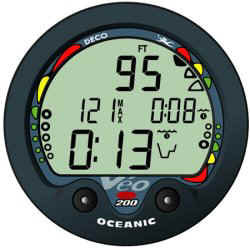
Most dive computers are made by just a few manufacturers, regardless of the brand. Oceanic, Genesis, Aeris, Sherwood, older Aqualung, and many of the other small "hockey puck" style computers (right) are all made by Pelagic Pressure Systems, a subsidiary of Oceanic. These all share similar if not identical features and use classic modified Haldane decompression algorithms. So-called "hockey puck" computers may be easily fitted into any spot that holds a standard depth gauge, whether it is a console, hose, or wrist mount.
The battery compartment design on all newer "Pelagics" is a train wreck - 4 small pieces that must be assembled just right, and the only way to tell is to drop it in the water and see if it floods. Together with the oddball battery they use, this is enough reason for me not to want one.
Suunto computers, distributed now by Aqualung and SeaQuest, use a different algorithm ( RGBM ) that is much more conservative, which is not necessarily a good thing ( see below. ) Uwatec/ScubaPro and Cochrane are the other major players with their own designs, and the rest are basically niche products. All of these computers are oddly shaped, fitting only into their own custom mounts, and often are only wrist-mountable. Most of these are also extremely (excessively) conservative. Uwatec has had a lot of product recalls lately, and is probably a good one to avoid.
There is a certain snobbishness about dive computers. In online discussions, Suunto and Uwatec owners especially tend to be quite vocal in their criticism of other dive computers, decompression models, etc. That doesn't mean that they are right. In fact, it doesn't mean that they know or understand anything at all about decompression models, or dive computers, or electronics, or diving, or anything; it just means that they need to justify the pile of money they spent. If even one of these people could explain to me exactly how the "superior" bubble model in their $1000 gadget actually works, I might take them more seriously. But since that's a big trade secret, I am not worried about it ever happening.
As you can see, I don't like hoseless or wrist-mounted gauges; I prefer my expensive equipment to be permanently attached to me. I also don't like to have my hands and arms encumbered, especially while hunting lobsters. Having spent the money for your new computer and gauges, you should get protectors for them to safeguard your investment. When scrambling over wet rocks, or bellying up to some nice rusty old wreck, or scrunching down in the sand to get that really big bug, you really don't want to scratch up your expensive equipment. For under $10, you don't have to.
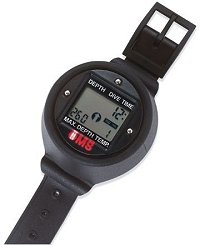
If you progress further into diving, beyond non-decompression recreational diving to technical diving, or if you simply have an interest in decompression theory, there are a number of PC-based dive simulation programs. These allow you to test custom dive profiles and decompression schedules from the safety of your armchair. Such schedules can also be used for actual dive planning with a simple bottom timer/depth gauge, as shown at right. Such a device is also a useful and prudent backup to a complex dive computer that may be prone to errors and failure.
Computer Conservatism and Other Subjects
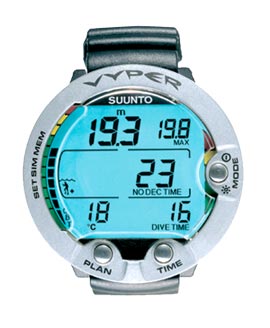
Different brands and models of dive computer vary in their degree of conservatism. By this, I mean that some will give you more bottom time and/or shorter decompression stops than others under the same conditions. A liberal computer will let you stay down longer, while a conservative one will want you out of the water sooner. You might think you are safer with a more conservative computer, but this is not necessarily the case, especially when doing decompression.
It is best to have a liberal dive computer that gives you minimum hang times, and use it conservatively. In other words, if for example, your computer tells you to hang ten minutes, you can then elect to hang five or ten more for safety margin. But in an emergency, such as out of air, storm building, large hungry fish, or if you really have to pee, you can just hang the minimum and get out, and be reasonably assured that you will be ok. After all, the manufacturer didn't design the computer to bend you, they designed it not to.
With a conservative computer that gives you double the hang times, you either have to wait out the whole thing or violate the computer. Some computers are so conservative that their owners habitually violate them, then hang them over the side of the boat for a while to clear the violation. What good is that? If your computer has user-changeable settings, set everything to the most liberal.
This same argument is also true when using dive planning software - make your tables as unconservative as possible, and then voluntarily extend your hang times for safety margin. By the way, this is not solely my own opinion, but the advice of some of the most respected and experienced technical divers in the world.
On another subject, almost all computers nowadays have an ascent rate meter built-in. This is a little piece of idiocy. Down deep, where it really doesn't matter, the ascent rate meter is reasonably accurate, but as you get close to the surface you are bound to violate it, especially if there is any kind of a rough sea running. You should learn how to do safe slow ascents without referring to your computer, and don't bother with the ascent rate meter.
Finally, what to do when your computer quits on you in the water? Needless to say, as soon as you find that your computer has died, you should abort the dive, and minimize any further nitrogen exposure. Without a computer, you probably now have neither a depth gauge nor a timer, and perhaps not an air gauge either. If possible, pair up with another diver and use their instruments to regulate your ascent and safety/decompression stops. Try to use someone who got in the water before you did, so your error will be on the safe side.
If you can't find anyone else and must fly blind, ascend the anchor line slowly by going up it steadily hand-over-hand, a few inches at a time. Ascend like this until you can see the surface, then drop back down ten feet or whatever it takes to be at a reasonable safety stop depth. Start counting slowly to 300 ( one-Mississippi, two-Mississippi ... ) That should give you roughly a five-minute stop time. Do it again if you are really worried. Don't worry about running out your air - at this depth, even a small amount of air will last a long time, and you are just a kick away from the surface in any case. When you get back to the boat, check your dive time and depth against the tables and other divers' computers ( they probably did pretty much the same profile that you did ) and convince yourself that you're ok, because you probably are.
If you plan to do any kind of deep diving or decompression, make sure you have redundant computers and instruments, so that this scenario does not arise!
If you have not seen a dive computer failure,
you have not been diving enough.
- DSAT Tec Deep Diver Manual pg 163
Update 2008 - My Gear
My first computer in 1996 was an air-integrated ( but not hoseless ) model. I went through three of these within the warranty period. On two of them, the tank pressure sensor drifted way out of calibration, while the third just blew up during a dive. I've seen other people have no problems with this exact same model, but that soured me on air integration, and I got the shop to replace it with another model in 1997.
That was a delightful little air-only console-mounted hockey puck, that worked so well that I bought a twin in 1999 so that I could dive with two when I wanted. After many years, in 2005 the elder of the two developed a leak ( see below ) but the second one still works perfectly. I replaced the dead computer with a new Oceanic Nitrox hockey puck. While that computer also worked quite well, it flooded immediately after the first battery change. I had it repaired, and even managed to successfully replace the battery once myself, but in 2008 the depth sensor went completely out of whack. Two repairs in three years - I don't think so.
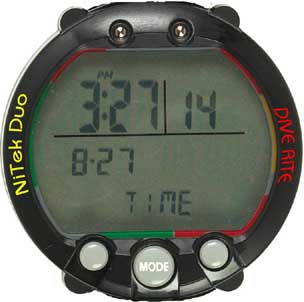
So in 2008, I went shopping again. I looked at a lot of models across all the manufacturers. If you've read the whole page up to here, then you can imagine I was pretty fussy. Eventually, I settled on a DiveRite Duo, pictured at right.
From a computer point-of-view, this is a very nice model that handles not one but two Nitrox mixes, that you can switch between during a dive. This means that it is capable of using Nitrox as a deco gas, rather than just as a bottom gas. It also has all the other bells and whistles you could want, but in a fairly clear display, with three control buttons. Here is the manual.
However, the physical design of the Duo ( and it's twin Tusa model ) is awful. The console version sits inside a hard plastic shell that offers little protection and no way to mount a compass. In addition, the hose is a special foreign model that is not interchangeable with standard American hardware. Too short at only 32" long, it is also too skinny to securely take a screw-on hose mount for a compass or other accessory. The wrist-mounted model is even worse. The strap is too short to have any hope of fitting around a drysuit sleeve, and it is attached directly to the plastic case of the computer with little pins, like an oversized cheap watch band. The computer itself is completely exposed to damage if you don't just outright lose it. This terrible design is not unique to DiveRite, but seems to be standard across almost all manufacturers nowadays. It is not what I would call "Jersey".
While I really liked the computer, actually integrating it into my dive kit looked bleak at first. The Duo may resemble a typical hockey puck, but it is in fact 1/2" greater in diameter, and will never fit into a standard stiff rubber or plastic gauge console. However, I was happily surprised to find that with a little dexterity, it can be stuffed into a thinner stretchier hose mount or a proper wrist mount, where it fits very securely, wrapped in a nice layer of protective rubber. The final result is this:
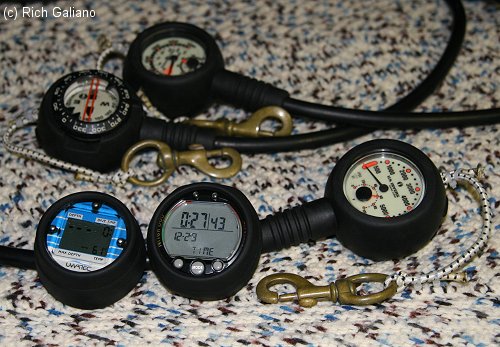
I stripped the now-useless computer mount off the end of my old rubber gauge console, and mounted the new computer down on the hose, along with my old bottom timer. Obviously, any combination of accessories is possible, including redundant computers. I don't need to hose-mount a compass, since the console already mounts one securely on the back of the pressure gauge. If assembled with care, I have found these hose-boots are reliable and trouble-free - I have used them for years.
The real beauty of this configuration is the flexibility - the expensive electronics are no longer married to the regulator, but can be easily removed. Thus I can quickly transfer the instruments to any one of my three main regulators, all of which have an identical pressure gauge setup. At the end of the day, I can take the computer inside and leave the wet gear in the garage. I can also select and rearrange the instruments as I see fit for a particular dive - no need to go rock climbing in the river with the expensive deco computer!
I came to this configuration in a roundabout way, but you could easily and inexpensively assemble it yourself, either from scratch or using parts you already have. Start out with a standard pressure gauge on a long hose - 40-42", 48" if you can find one. Mount one of these on each regulator. To this, add a hose-mounted compass and some kind of terminal clip or retractor. Then place your electronics in hose boots, and mix and match as necessary, selecting and arranging your instruments as you see fit, and not as some manufacturer thinks they should be.
This modular design has other advantages as well. Mixing parts across manufacturers is no issue at all. Future upgrades are not a problem, and maintenance is enhanced: if any discrete part fails, simply replace it, without affecting any other parts. Funny how this configuration mimics the old three-hole hard plastic console, except with the SPG at the top instead of the bottom.
DIR
DIR eschews complex, failure-prone dive computers for simple bottom timers and pre-cut decompression schedules. This is not entirely a bad idea, especially for technical diving. However, as usual, this is overly strict for simple recreational diving and even minor decompression.
Wrist-mounted gauges seem to be preferred, and protective boots or consoles are forbidden, both things with which I disagree for wreck diving. I have also seen it stated that no more than one depth gauge is necessary per buddy team. In a cave, this might work, but in the open North Atlantic it would be suicidal for at least one member of the "team."
Beginner Recommendation:
Whether you plan to dive locally, or only in the tropics, a good dive computer should be one of the first items you get. Dive computers have become quite inexpensive in recent years. My own preference is for the non-air-integrated hockey-puck-style computer. Among various models from the brands available, look for the following features:
- flexible mounting options, including console, wrist, and hose
- clear, easily understood numerical and bar graph displays
- two-button control interface
- Nitrox capable
- gauge mode
- backlighting, clock, & thermometer
- user-replaceable batteries
A computer with all these features should last you from your beginning days well into your diving career.
While air and Nitrox computers for recreational diving as described above have proven to be safe, reliable, and easy to use, the same cannot be said for "technical" computers, designed for mixed-gas decompression diving. Many of these are riddled with dangerous flaws, and many more no doubt have flaws that are yet to be uncovered. Here is just one horror story:
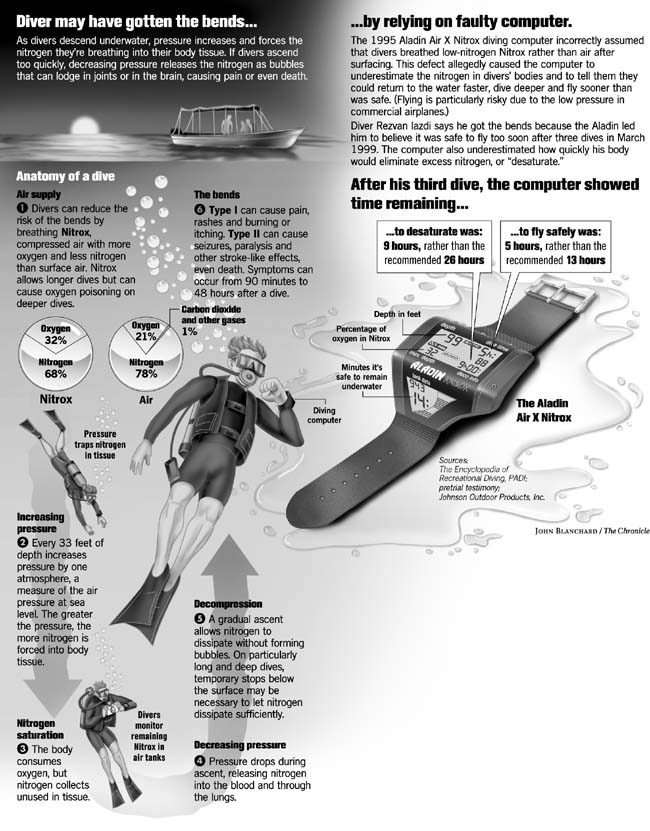
On the Inside
Here are the guts of an old dive computer that finally gave up the fight:
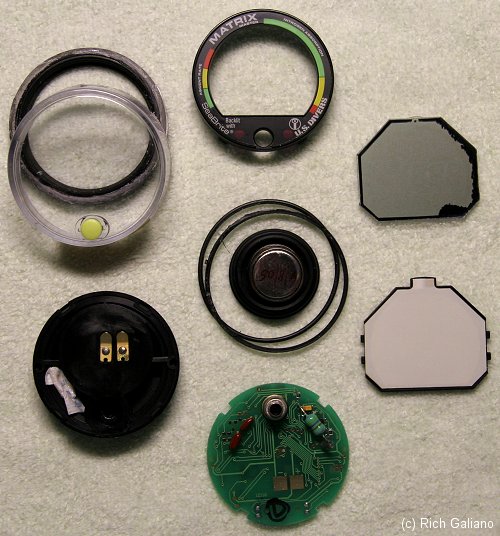
- Outer casing - cut in two with a Dremel, since it would not unscrew
- Display bezel
- Display - the LCD is obviously ruined
- Backlight
- Circuit board, flipped over, with pressure sensor at top
- Back / battery compartment, with small pack of silica gel
In the center are the batteries, battery cover, and miscellaneous O-rings. The actual computer chips are on the other side of the circuit board, obscured by big globs of epoxy. The parts stack or nest top-to-bottom in the order they are listed.

